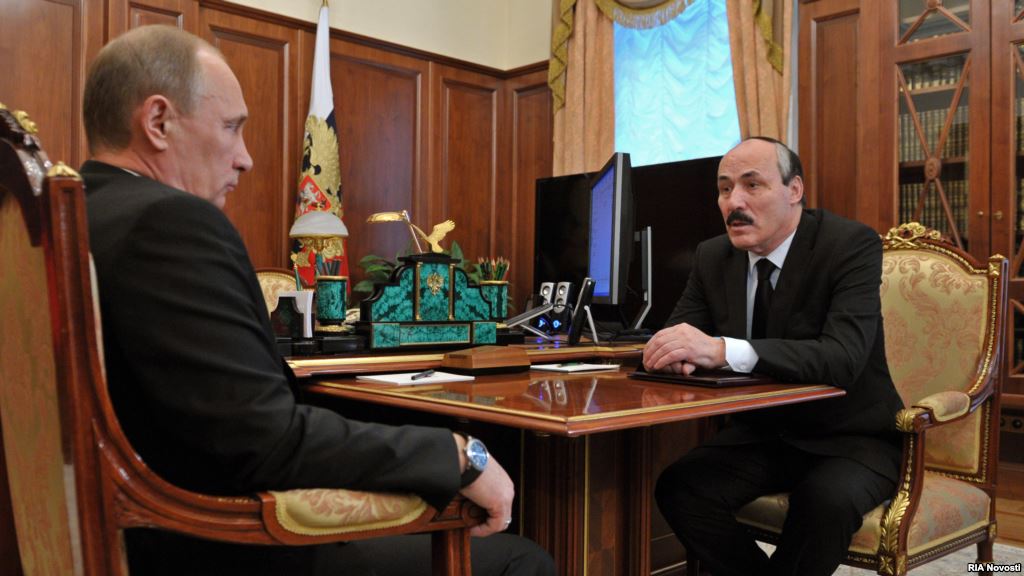
North Caucasus Leaders Seek Greater Autonomy and Access to Local Natural Resources
Publication: Eurasia Daily Monitor Volume: 11 Issue: 28
By:

At the meeting of the Russian Ministry for Regional Development on February 4, Dagestan’s leader Ramazan Abdulatipov said the central government in Moscow should give the regions the right to administer regional resources if it cannot do it properly itself. Abdulatipov provided an example, noting that Dagestan was buying 85 percent of its natural gas supplies from other regions of the Russian Federation, while its own natural gas deposits were estimated at 800 billion cubic meters. “We do not manage [our] resources,” he said. “I tell the federal center—either manage [them] effectively yourself or give this right to the regions. We practically have no resources for development.” The head of Dagestan decried the paternalist policies of Moscow, saying that the central government’s disbursals of funds were not sufficient. “I will receive money [from Moscow] for a perinatal center and that is good, but the republic’s development is more important to me, so that I could resolve the problems myself,” Abdulatipov said. The expansion of the North Caucasian Federal District “after the Olympics” to include Krasnodar and Rostov regions to the north was among the other proposals made by the leader of Dagestan. Abdulatipov suggested that greater regional cooperation should improve the integration of the country and its economy (https://www.kommersant.ru/doc/2400471).
Notably, Moscow’s own appointees in the North Caucasus are frustrated by the hyper-centralized policies of the central government and have even spoken out against them publicly. This is a sign of the inevitable failure of the current policies of Moscow, which strives to tie potentially separatist-minded regions to the country through subsidies. The flipside of this client-patron relationship is that for the subsidies to be an attractive option for the region, the economic situation on the ground has to be relatively dire. Thus, while Moscow, on the one hand, does not want to bear the brunt of helping increasingly less economically efficient regions, at the same time, it fears overly high economic development in ethnically non-Russian areas of the country like the North Caucasus.
The participants in the February 4 government meeting reviewed the North Caucasus Federal District Social and Economic Development Strategy to 2025 and came to the conclusion that governmental resources did not provide the necessary basis for the program. The program was adopted with great fanfare back in 2010. The initial estimates for the funding were up to $125 billion, of which $84 billion was supposed to come from the central government’s coffers. But the Russian government’s dwindling finances resulted in much less aid to the North Caucasus than was promised. In 2012, the Ministry for Regional Development asked the government only for $55 billion, but was turned down. Moscow ultimately decided to continue financing the North Caucasus at the subsistence level of about $1 billion a year. Having failed to make good on its promise to raise living standards in the North Caucasus, the Russian government now expects to improve the climate for foreign investment (https://www.kommersant.ru/doc/2400471).
The question, of course, is how serious Moscow is about attracting foreign investment into the North Caucasus, given its worries about separatism in this peripheral region. Even if Moscow were actually interested in attracting foreign investment to the North Caucasus, it is unclear how the government would be able to reassure foreign investors about the continually precarious security situation in the region.
The government strategy for the development of the North Caucasus adopted back in 2010 forecast that the number of unemployed in the region would reach 400,000 by 2015 if nothing was done by the government. The strategy proposed creating a government Agency for Labor Migration, as a quick fix to remedy the imbalances and to encourage North Caucasians to settle in other Russian regions where work is more abundant (https://krskfo.ru/en/44).
However, even this relatively easy move was not implemented, probably in part because of the ever-present danger of clashes between ethnic Russians and ethnic North Caucasians like those that shook Russia in recent years.
Meanwhile, the Russian government’s agency for regional development has reported that the gap between the economic situation in the North Caucasus and the rest of Russia continues to widen. According to some experts, the economic indicators in all parts of the North Caucasus, including the majority ethnic Russian region of Stavropol, deteriorated further from 2010–2013. Many indicators suggest that the six North Caucasian republics are at the bottom among Russia’s 89 regions. “If we look at the research on the investment attractiveness of the regions by the Ekspert RA agency, the republics of the North Caucasus have traditionally occupied the last positions in Russia in terms of financial risks without any upward trends, as they cannot go down any further,” Kavpolit.com website journalist Filipp Gromyko sarcastically pointed out (https://kavpolit.com/articles/minregion_preduprezhdaet-258/).
As the economic situation in the North Caucasus deteriorates and Russia faces tighter budgets, even the regional leaders completely loyal to Moscow are voicing concern and demanding greater autonomy in managing their resources. Moscow’s own strategy of increasing the dependence of the regions on the central government’s budget while trying to improve the region’s economic efficiency is inherently contradictory.




